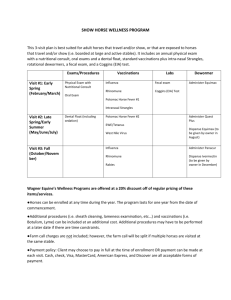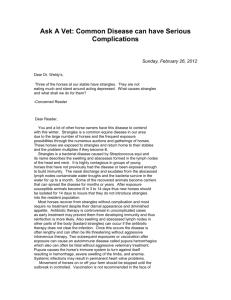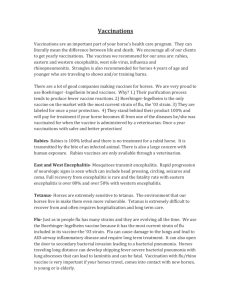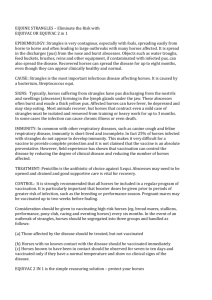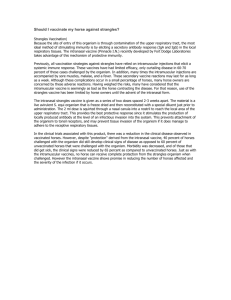Strangles Information Page
advertisement
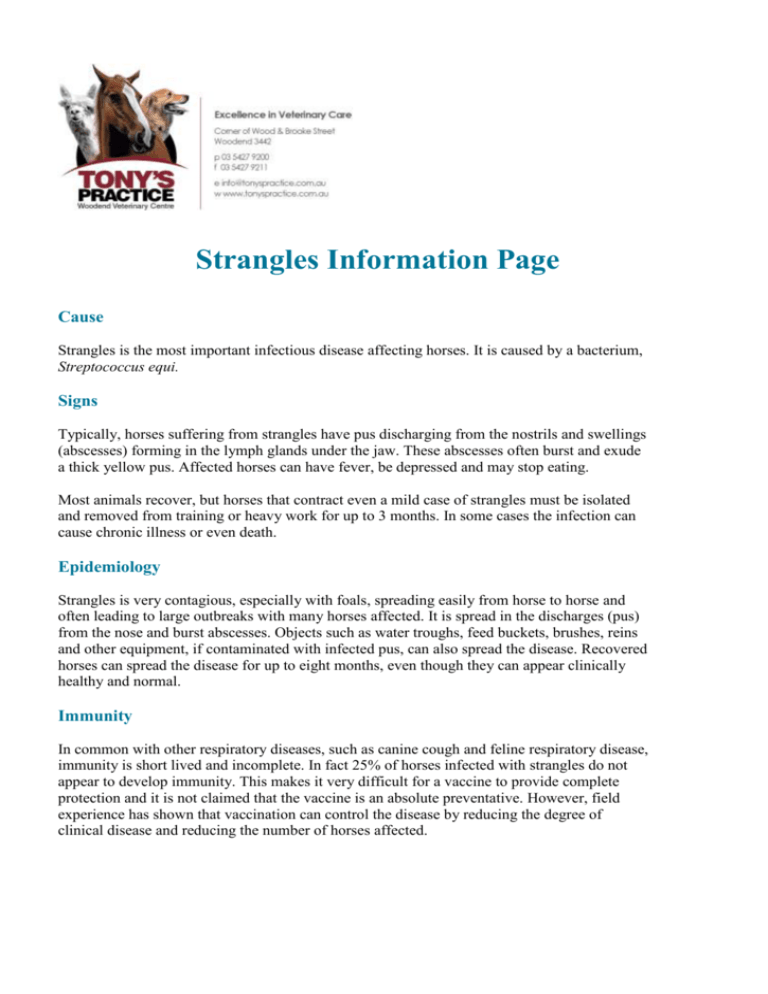
Strangles Information Page Cause Strangles is the most important infectious disease affecting horses. It is caused by a bacterium, Streptococcus equi. Signs Typically, horses suffering from strangles have pus discharging from the nostrils and swellings (abscesses) forming in the lymph glands under the jaw. These abscesses often burst and exude a thick yellow pus. Affected horses can have fever, be depressed and may stop eating. Most animals recover, but horses that contract even a mild case of strangles must be isolated and removed from training or heavy work for up to 3 months. In some cases the infection can cause chronic illness or even death. Epidemiology Strangles is very contagious, especially with foals, spreading easily from horse to horse and often leading to large outbreaks with many horses affected. It is spread in the discharges (pus) from the nose and burst abscesses. Objects such as water troughs, feed buckets, brushes, reins and other equipment, if contaminated with infected pus, can also spread the disease. Recovered horses can spread the disease for up to eight months, even though they can appear clinically healthy and normal. Immunity In common with other respiratory diseases, such as canine cough and feline respiratory disease, immunity is short lived and incomplete. In fact 25% of horses infected with strangles do not appear to develop immunity. This makes it very difficult for a vaccine to provide complete protection and it is not claimed that the vaccine is an absolute preventative. However, field experience has shown that vaccination can control the disease by reducing the degree of clinical disease and reducing the number of horses affected. Treatment Penicillin is the antibiotic of choice against S.equi. Abscesses may need to be opened and drained and good supportive care is vital for recovery. Control It is strongly recommended that all horses be included in a regular program of vaccination. It is particularly important that booster doses be given prior to periods of greater risk of infection, such as the breeding or performance season. Pregnant mares may be vaccinated up to two weeks before foaling. Consideration should be given to vaccinating high risk horses (eg. brood mares, stallions, performance, pony club, racing and eventing horses) every six months. In the event of an outbreak of strangles, horses should be segregated into three groups and handled as follows: (a) Those affected by the disease should be treated, but not vaccinated (b) Horses with no known contact with the disease should be vaccinated immediately (c) Horses known to have been in contact should be observed for seven to ten days and vaccinated only if they have a normal temperature and show no clinical signs of the disease. Why vaccinate? Vaccination provides the best possible protection against strangles which is the most important infectious disease problem for horses. Does the vaccine provide 100% protection? Field experience suggests that a full and regular program of vaccination for all horses will usually control or very markedly reduce the incidence and severity of strangles. However it is not claimed that the vaccine is an absolute preventative. Vaccination will reduce the spread in an outbreak with less horses affected by strangles and those that do show signs have a milder disease with shorter recovery and possible protection against spread through the body. Thus, vaccination has good benefits and is the best protection possible. It should be pointed out that there are other diseases, caused by different organisms, which may be confused with strangles. Can the vaccine be used during an outbreak? Yes. In the event of an outbreak of strangles, horses should be segregated into three groups, Those affected by the disease should be treated, but not vaccinated. Horses with no known contact with the disease should be vaccinated immediately. Horses known to have been in contact should be observed for seven to ten days and vaccinated only if they have a normal temperature and show no clinical signs of the disease. Does the vaccine cause reactions? Like a number of other vaccines, Equivac-S or Equivac 2 in 1 can cause some local swelling at the site of the injection, especially if injected subcutaneously and not intramuscularly. Provided the injection has been carried out aseptically, any swelling should disappear in a few days. What is the vaccination schedule? When horses and foals are vaccinated against strangles for the first time, they require a primary vaccination course consisting of three doses of Equivac-S or Equivac 2 in 1. The three doses are given with an interval of two weeks between injections. Booster doses should be given at least annually and six-monthly revaccination should be considered in circumstances where the risk of infection is known to be high. What are the signs of strangles? Typically, horses suffering from strangles have pus discharging from the nostrils and swellings (abscesses) forming in the lymph nodes (glands) under the jaw. Most animals recover, but horses that contract even a mild case of strangles must be isolated and removed from training or heavy work for up to 3 months! In some cases the infection can cause chronic illness or even death. How is the vaccine administered? The vaccine is injected intramuscularly. The most convenient site for injection is the centre of the side of the neck. The needle can be attached to the syringe and then administered to the horse. Alternatively, the needle may be inserted into the muscle and then the syringe attached and the vaccine injected.
